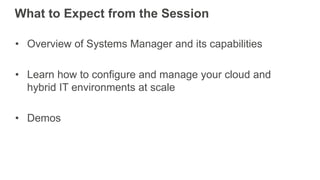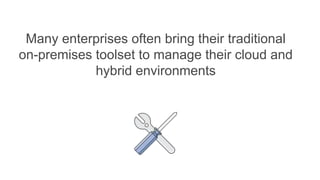NEW LAUNCH! Amazon EC2 Systems Manager for Hybrid Cloud Management at Scale
- 1. © 2016, Amazon Web Services, Inc. or its Affiliates. All rights reserved. Dean Samuels Manager, Solutions Architecture Hong Kong & Taiwan 19th January 2017 New Launch! Amazon EC2 Systems Manager Hybrid Cloud Management at Scale
- 2. What to Expect from the Session • Overview of Systems Manager and its capabilities • Learn how to configure and manage your cloud and hybrid IT environments at scale • Demos
- 3. Cloud is the new normal – enterprises of all sizes are moving to the cloud to take advantage of increased agility, lower costs, and a global reach
- 4. Many enterprises often bring their traditional on-premises toolset to manage their cloud and hybrid environments
- 5. What we heard from customers • Traditional IT tools not built for the cloud • Managing resources at scale is difficult • Lack of visibility into configuration and execution history • Multiple vendors; complex licensing Managing cloud and hybrid environments using traditional tools is complex and costly
- 6. Introducing EC2 Systems Manager A set of capabilities that enable automated configuration and ongoing management of systems at scale, across all of your Windows and Linux workloads, running in Amazon EC2 or on-premises
- 8. Why should I care? Hybrid Cross-platform Scalable Secure Easy-to-write automation Reduced TCO
- 9. Systems Manager capabilities Run Command Maintenance Window Inventory State Manager Parameter Store Patch Manager Automation Deploy, Configure, and Administer Track and Update Shared Capabilities
- 10. Documents
- 11. Parameter Store • Parameters reference-able via a Run Command, State Manager, and Automation Service • Granular access control limits unwanted data access • Encrypt sensitive information using your own AWS KMS keys • Eliminates on-going maintenance challenge of critical enterprise assets Centralized management of IT assets such as passwords and connection strings
- 12. Parameter Store – Getting Started 1. Set parameters as key-value pairs 3. Reuse: In Documents and easily reference at runtime across EC2 Systems manager using {{ssm:parameter- name}} 4. Access Control: Create an IAM policy to control access to specific parameter 2. Secure strings: encrypt sensitive parameters with your own KMS or default account encryption key
- 13. Maintenance Window • Define one or more recurring windows of time during which it is acceptable for disruptive actions to occur • Built-in integration with Run Command and Patch Manager • Helps improve availability and reliability of your workloads by automatically performing tasks in a well-defined window of time Schedule disruptive tasks in well-defined window to minimize downtime
- 14. Run Command • Example: Running shell and PowerShell scripts • Easily define new tasks using simple JSON-based Documents – no specialized skillset required • Leverage Documents built by AWS and the broader community • Delegate access, perform audit, receive notifications • Helps improve security posture by eliminating the need to SSH or RDP Perform common administrative tasks remotely at scale
- 15. Run Command – Getting Started 1. Instance: Setup agent, AWS Identity & Access Management (IAM) role on your instance. On-premise servers: create activation code, deploy agent and activate 3. Command and Command Invocation on target instances and on-premise servers 4. View status and output – granular results 2. Create Document to author your intent, define the plugins to run and parameters to use
- 16. State Manager • Example: Configuring firewall and updating anti-malware definitions • Define new policies using simple JSON-based Documents • Control how and when a configuration is applied and maintained • Helps enforce enterprise-wide compliance of configuration policies • Re-apply to keep servers from drifting • Track aggregate status for your fleet Define and maintain a consistent configuration of OS and applications
- 17. State Manager – Getting Started 1. Create Document to author your intent 3. Schedule: When to apply your association 4. Status: Check the state of your association at an aggregate or instance level 2. Association: Binding between a document and a target
- 18. Automation Service • Optimized for building and maintaining Amazon Machine Images (AMIs) • Start with an AMI perform automation steps like OS patching and drive updates produce a new AMI • Express your workflow as automation steps in a JSON-based Document • Support for Run Command, AWS Lambda functions, AWS CloudTrail, IAM and Amazon CloudWatch integrations • Eliminates the overhead in managing ‘golden’ enterprise images Automate common tasks using simplified workflows
- 19. Automation – Getting Started 1. Create an automation document 2. Run automation 3. Monitor your automation
- 20. Walkthrough Demo
- 21. Inventory • Example: Instance and OS details, network configuration, list of files, installed software and patches • Collect data from predefined inventory types or write a custom one using JSON Document • AWS Config integration enables tracking the history of changes • Simplifies management scenarios, such as licensing usage tracking and identifying zero-day vulnerabilities Scalable way of collecting, querying, and auditing detailed software inventory information
- 22. Inventory – Getting Started 1. Configure Inventory policy 2. Apply Inventory policy 3. Query inventory
- 23. Walkthrough Demo
- 24. Inventory – System Diagram SSMAgent EC2 Windows Instance SSMAgent EC2 Linux Instance SSMAgent On- Premises Instance AWS SSM Service State Manager EC2 Inventory SSM document Inventory Store EC2 Console, SSM CLI/APIs AWS Config AWS Config Console + CLI/APIs
- 25. Patch Manager • Express custom patch policies as patch baselines, e.g., apply critical patches on day 1 but wait 7 days for non-critical patches • Perform patching during scheduled maintenance windows • Built-in patch compliance reporting • Eliminates manual intervention and reduces time-to-deploy for critical updates and zero-day vulnerabilities Roll out Windows OS patches using custom-defined rules and pre-scheduled maintenance windows
- 26. Patch Manager – Getting Started 1. Create a Patch Baseline to define approved patches 3. Maintenance Window executes patching 4. Audit results with Patch Compliance 2. Create a Maintenance Window to schedule patching for a set of instances
- 27. Patch Manager - Overview Prod Environment Instance A Patch Group:Prod Patch Baseline - Critical, High - 5 days or older 1 Maintenance Window - Sundays @ 1AM - 2 hrs. long - Task: Patching 2 3 Patch Compliance 2 up to date 0 missing updates 1 error 4 Instance B Patch Group:Prod Patch Group:Prod
- 28. Best-practices and FAQs • What OS platforms are supported? • Update your SSM agent today to get started! • What ports or network access do my instances need? • Is there anything different to set up on-premises servers? • Use notifications, velocity control • For disruptive actions, use Run Command with Maintenance Window • Fine-grained access control through IAM policies on resources (e.g. documents) • Customize configuration with idempotent scripts for State Manager
- 29. Systems Manager availability • No charge – only pay for AWS resources you manage • Available in multiple regions
- 30. Systems Manager capabilities Run Command Maintenance Window Inventory State Manager Parameter Store Patch Manager Automation Deploy, Configure, and Administer Track and Update Shared Capabilities
- 31. Your Feedback is Important! • These services are available today • Learn more at https://aws.amazon.com/ec2/run- command/ • Technical documentation at http://docs.aws.amazon.com/AWSEC2/latest/UserGuide/ run-command.html • Please send your feedback, improvements, requests to ec2-ssm-feedback@amazon.com
- 32. Next steps • Learn more at https://aws.amazon.com/ec2/systems- manager/ • Join us at the booth! We’d love to hear your feedback.
- 33. Remember to complete your evaluations!
- 34. Thank you! Dean Samuels Manager, Solutions Architecture Hong Kong & Taiwan 18/01/2017
Editor's Notes
- #19: Automation pain point: AMI building Triggers: patching, hardening, application bake-in Never-ending Time consuming, especially when builds fail Overhead of maintaining build service
- #22: What we heard: Accurate software inventory is critical for understanding fleet configuration and license usage Legacy solutions not optimized for cloud Self-hosting requires additional overhead
- #26: What we heard about patching enterprise systems: Time consuming, tedious, repetitive Existing solutions are inadequate Enterprise patching is manual and complex Errors result in downtime, compliance issues


































